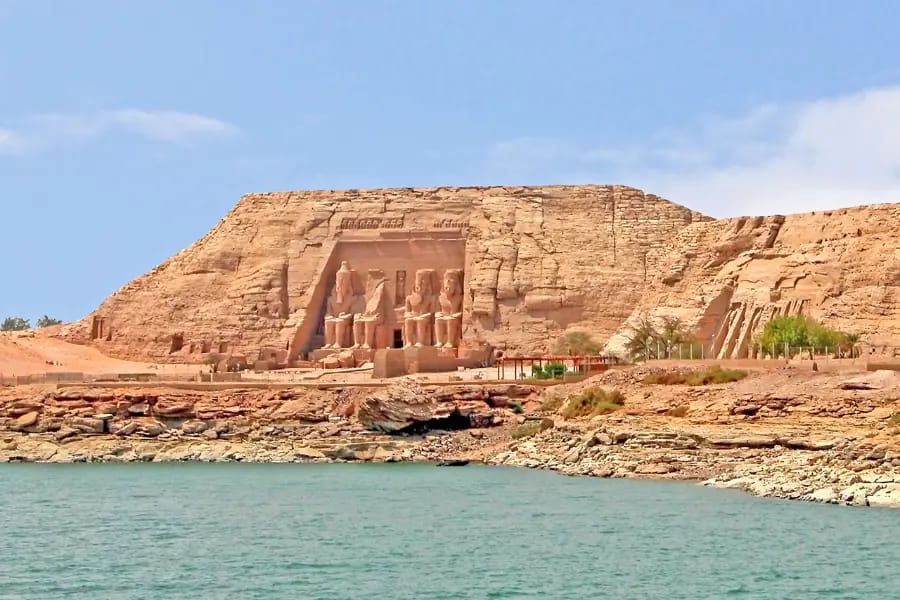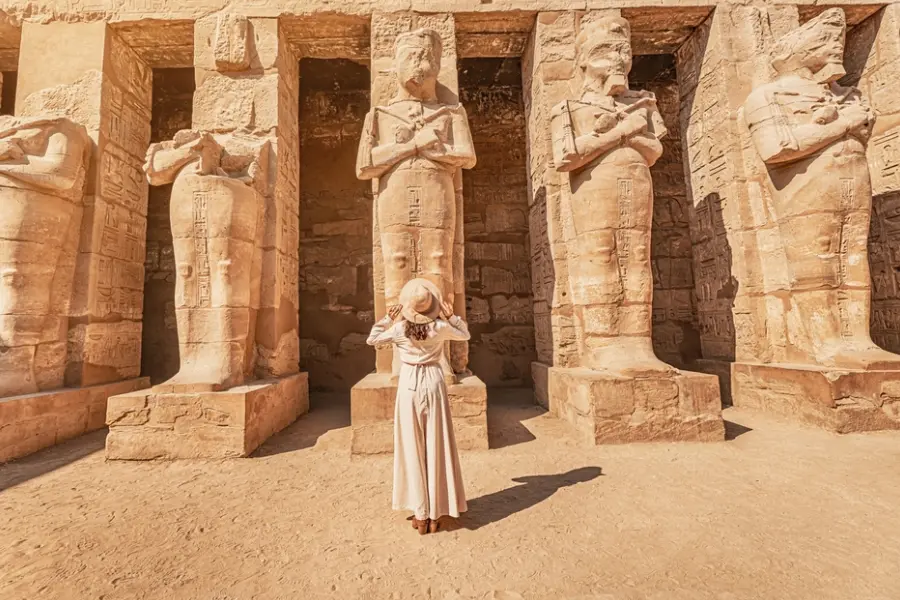Pyramid of Menkaure: History, Facts and Visiting Guide
In the heart of ancient Egypt, where mighty pharaohs ruled and timeless wonders rose from the desert sands, stands the smallest of the Pyramids of Giza — the Pyramid of Menkaure. Though often overshadowed by Khufu and Khafre, it preserves unique secrets and architectural beauty that continue to captivate visitors today.
This guide explores the Menkaure Pyramid, shedding light on its history, construction, symbolism, and visitor tips. By the end, you’ll see why this so-called “smallest pyramid” is an essential piece of Egypt’s monumental heritage.
Key Takeaways
- The Pyramid of Menkaure is the third and smallest of the Giza pyramids.
- Built for Pharaoh Menkaure of Egypt’s Fourth Dynasty (c. 2530 BCE).
- Originally stood at 66 meters; today measures about 62–65 meters due to erosion.
- Notable for its unique granite casing from Aswan and refined proportions.
- Part of a larger funerary complex with temples, causeways, and satellite pyramids.
- Important archaeological finds include Menkaure’s sarcophagus and statues.
- Still a major highlight for visitors to the Giza Plateau today.
What is the Pyramid of Menkaure?
The Pyramid of Menkaure, also called the Menkaure Pyramid, is the third and smallest of the three Giza pyramids. Built during Egypt’s Fourth Dynasty as King Menkaure’s final resting place, it is renowned for its elegant granite casing and balanced proportions, making it a distinctive part of the Giza Plateau.
Although smaller than Khufu’s and Khafre’s pyramids, the Menkaure Pyramid completes the iconic Giza trio. Its unique design and durable granite casing showcase the artistry of ancient Egyptian builders and ensure its lasting place among the world’s great monuments.
Who Was Pharaoh Menkaure?
Pharaoh Menkaure, also known as King Menkaure of Egypt’s Fourth Dynasty, was the son of Khafre and grandson of Khufu. His reign in the 26th century BCE was marked by prosperity, cultural growth, and the construction of the Menkaure Pyramid, the smallest of the three on the Giza Plateau.
- King Menkaure was the son of Pharaoh Khafre and the grandson of Pharaoh Khufu, builder of the Great Pyramid of Giza.
- His reign brought stability, economic prosperity, and a flourishing of art and culture.
- Although his pyramid is the smallest at Giza, it stands as a lasting symbol of his legacy.
- The famous Triad of Menkaure statue depicts him with the goddess Hathor and a deified nome, symbolizing his divine role as mediator between gods and people.
- His legacy endures through his pyramid and the many statues and reliefs that reflect his strength and divine-like image.
When Was the Pyramid of Menkaure Built?
The Pyramid of Menkaure was constructed around 2530 BCE, most likely between 2532 and 2504 BCE, during Egypt’s Fourth Dynasty. Like his predecessors, Pharaoh Menkaure aimed to create a monument that would last for eternity, and his pyramid continues to stand as a lasting symbol of his reign.
Where Is the Pyramid of Menkaure Located?
The Menkaure Pyramid stands on the Giza Plateau, next to the larger pyramids of Khufu and Khafre. Together, they form the world-famous Giza pyramid complex, the only surviving wonder of the ancient world. Rising from the desert, these monuments remain one of the most awe-inspiring sights in Egypt.
How Tall Is the Pyramid of Menkaure?
The Pyramid of Menkaure originally stood at about 66 meters (216 feet). Over the centuries, erosion and the loss of its granite casing reduced its height slightly.
Today, the pyramid measures between 62 and 65 meters (213–215 feet). Despite this change, it remains a remarkable feat of ancient Egyptian engineering and a striking monument on the Giza Plateau.
How Was the Pyramid of Menkaure Constructed?
The Pyramid of Menkaure was built with massive limestone blocks and fine granite casing, showcasing the engineering skills of ancient Egyptian builders. Workers used copper tools, sledges, and ramps to assemble the pyramid with precision and durability.
- The pyramid’s core was made of limestone quarried locally, while the lower courses were faced with red granite from Aswan for strength and prestige.
- Stone blocks were cut and shaped with copper chisels, then transported on wooden sledges and rollers, likely with sand lubrication to ease movement.
- On site, blocks were carefully aligned and stacked layer by layer to maintain symmetry and stability.
- Internal passageways and chambers were carved during construction, while ramps were used to raise materials as the pyramid rose in height.
- The project reflects the advanced techniques of Old Kingdom builders, who achieved monumental results without modern machinery.
What’s Inside the Pyramid of Menkaure?
Inside the Pyramid of Menkaure are narrow passages and chambers that lead to a central burial chamber. Built to hold the king’s sarcophagus and funerary goods, the design reflects both practical function and deep religious symbolism tied to the pharaoh’s journey to the afterlife.
The internal layout highlights the precision of ancient Egyptian builders. Corridors were carved deep into the pyramid, creating a secure resting place for the king while symbolizing his transition to the eternal realm.
What Treasures or Artifacts Have Been Found Inside?
Archaeologists uncovered several artifacts linked to the Pyramid of Menkaure, including his red granite sarcophagus, statues, jewelry, and funerary objects. These finds reveal burial practices and artistry of Egypt’s Fourth Dynasty.
Not all of the items were discovered inside the pyramid itself, but together they provide valuable insight into royal funerary traditions and the cultural richness of Menkaure’s reign.
What Was the Pyramid’s Role in Menkaure’s Funerary Complex?
The Menkaure Pyramid formed the heart of his funerary complex, surrounded by temples, causeways, and subsidiary pyramids. Each structure supported rituals to ensure the king’s safe journey into the afterlife.
This layout reflected the Egyptians’ deep religious beliefs. The pyramid stood as the pharaoh’s eternal resting place, while the valley and mortuary temples hosted ceremonies that honored his divine role even after death.
Stories and Secrets of King Menkaure’s Pyramid
The Pyramid of Menkaure is surrounded by fascinating stories and legends. From its vision and construction to its sacred burial chamber, these tales reflect the ambition, artistry, and spiritual beliefs of ancient Egypt’s Fourth Dynasty.
Chapter 1: A Vision Takes Shape
In the Fourth Dynasty, King Menkaure sought to leave a lasting legacy. His pyramid was built to symbolize his reign and ensure his memory endured for generations.
Chapter 2: The King’s Search for Perfection
Architects selected the Giza Plateau, where the Nile meets the desert — a location that embodied the beauty and spirit of Egypt.
Chapter 3: Unleashing the Power of Stone
Workers quarried fine limestone from Tura and transported it to Giza. The pyramid’s construction demonstrated skill, endurance, and remarkable precision.
Chapter 4: A Towering Vision Rises
As the structure rose, artisans carved reliefs and symbols of power and divinity, making the pyramid not just a monument but a statement of eternal rule.
Chapter 5: Guardians of the Afterlife
Inside, Menkaure’s red granite sarcophagus was placed within a sacred chamber, surrounded by treasures intended to guide him into the afterlife.
Chapter 6: Legacy of the Sands
Though smaller than Khufu and Khafre’s pyramids, Menkaure’s tomb remains a timeless reminder that greatness is defined by vision and courage, not size.
Tips for Visiting the Pyramid of Menkaure
Visiting the Pyramid of Menkaure is a unique chance to experience Egypt’s ancient heritage. Here are practical tips covering location, tickets, tours, and how to make the most of your trip.
- Location: The pyramid is on the Giza Plateau near Cairo, part of the complex with Khufu and Khafre’s pyramids.
- Entry Fees: Access requires a Giza Plateau entrance ticket, available at the main gate.
- Guided Tours: Hiring an Egyptologist guide enriches your understanding of the pyramid and nearby monuments.
- Opening Hours: Generally open from early morning until late afternoon; confirm seasonal hours before visiting.
- No Climbing: Climbing the Pyramid of Menkaure or any pyramid is prohibited, though some are open for interior visits.
- Photography: Walk around the pyramid’s base for striking views and memorable photos.
- Valley Temple: Visit the nearby Valley Temple of Menkaure for insight into funerary rituals and religious beliefs.
- Dress Comfortably: Lightweight clothing and sturdy shoes are best for sandy, uneven ground.
- Weather & Hydration: Expect heat, especially in summer—carry water, sunscreen, and a hat.
- Respect the Site: Follow posted rules and avoid touching or climbing on the stones.
Symbolism and Restoration of the Pyramid of Menkaure
The Pyramid of Menkaure, also called the Mykerinos Pyramid, is the smallest of the three Giza pyramids. Its reduced scale sparked debate—was it symbolic, economic, or practical?
Symbolism: Some scholars argue Menkaure deliberately built a smaller pyramid to emphasize modesty and religious devotion, shifting focus from size to spiritual meaning. Others suggest economic limits or political changes influenced its scale.
Restoration: In modern times, the pyramid has faced erosion, collapsed casing stones, and damage from past excavations. The Egyptian Ministry of Antiquities and UNESCO have carried out stabilization projects, reinforcing the granite base and improving visitor access.
Recent Discoveries: Excavations near Menkaure’s valley temple revealed statues, offering vessels, and evidence of unfinished construction phases, deepening our understanding of the Old Kingdom’s engineering and beliefs.
Comparison with the Pyramids of Khufu and Khafre
The Pyramid of Menkaure is often compared with the larger pyramids of Khufu and Khafre. Together, they form the iconic Giza Plateau, each reflecting different royal ambitions and resources.
- Khufu’s Great Pyramid: The largest at 146 meters, symbolizing immense royal power and engineering mastery.
- Khafre’s Pyramid: Slightly smaller at 136 meters, but built on higher ground, giving the illusion of equal height.
- Menkaure’s Pyramid: The smallest at 65 meters, notable for its red granite casing and more modest scale.
This comparison highlights how each pharaoh used pyramid construction not only as a tomb but as a statement of authority, belief, and legacy within the Fourth Dynasty.
Quick Facts about the Pyramid of Menkaure
| Fact | Details |
|---|---|
| Name | Pyramid of Menkaure (Pyramid of Mykerinos) |
| Location | Giza Plateau, near Cairo, Egypt |
| Dynasty | Fourth Dynasty, Old Kingdom |
| Builder | Pharaoh Menkaure, son of Khafre |
| Construction Date | Circa 2530 BC |
| Original Height | 66 meters (216 feet) |
| Current Height | 62–65 meters (203–213 feet) |
| Base Length | 102.2 meters (335 feet) |
| Materials | Core of limestone, lower casing of granite from Aswan |
| Purpose | Royal tomb and symbol of divine kingship |
Recommended Tours Including the Pyramid of Menkaure
Several Egypt tour packages feature the Pyramid of Menkaure along with the wonders of the Giza Plateau. Here are our top recommended itineraries to suit every traveler.
Multi-Day Egypt Tours including Giza Pyramids
- 5 Days Cairo and Bahariya Oasis Tour – History, Nature & Culture
Discover pharaonic heritage and desert beauty in Cairo and the Bahariya Oasis. - 7 Days Cairo, Luxor and Hurghada Tour – History & Red Sea Fun
See the Giza Pyramids, ancient Luxor, and relax on the Red Sea. - 9 Days Egypt Tour: Cairo, Alexandria & Nile Cruise Adventure
A well-rounded trip through top destinations with a scenic Nile cruise. - 10 Days Cairo, Luxor and Hurghada Holiday – Explore Egypt
Enjoy Egypt’s culture, history, and seaside fun. - 13 Days Egypt Holiday: Cairo, Alexandria, Siwa, Abu Simbel and Luxor
A grand tour of Egypt’s landmarks, from the pyramids to Siwa and Abu Simbel.
Short Cairo Tours (Perfect for Limited Time)
If you have limited time but still want to see the Pyramid of Menkaure, consider these popular Cairo day tours:
- 3 Days Cairo Tour Package
A short trip featuring the Giza Pyramids, Egyptian Museum, and more. - Fascinating Cairo Full Day Tour
Explore Cairo’s highlights in a single well-organized day. - Breathtaking Cairo Stopover Tour
Perfect for transit travelers — see the Giza Pyramids and city highlights in just hours.
Shore Excursions for Cruise Passengers
Cruise passengers can explore the Giza Pyramids, including the Pyramid of Menkaure, through guided shore excursions.
Browse Our Egypt Shore Excursions
These tours include private transfers, expert guides, and itineraries tailored to fit your ship’s schedule.
Frequently Asked Questions about the Pyramid of Menkaure
Plan Your Visit to the Giza Pyramids
Discover the wonders of the Pyramid of Menkaure and the entire Giza Plateau with our tailored Egypt tour packages. Whether a short day trip or a full holiday, we’ve got you covered.












